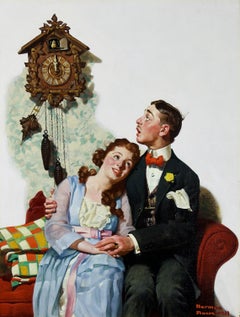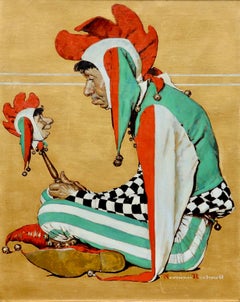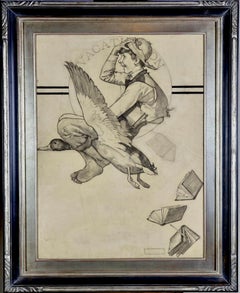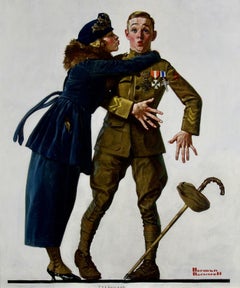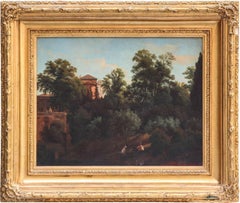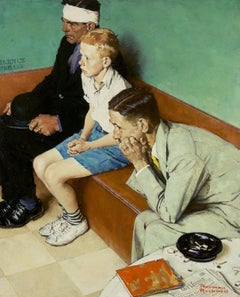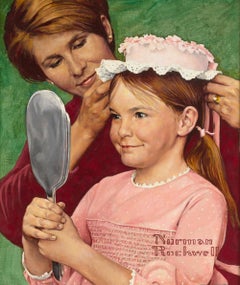Norman Rockwell Paintings
Norman Rockwell is among the most revered painters of the 20th century. His figurative and portrait paintings reflect an innocent and idyllic America described by the artist as "life as I would like it to be." For nearly 50 years, he illustrated the covers of The Saturday Evening Post in a rich and emotive style that gave distinctive personalities to his imagined characters. In total, Norman Rockwell created more than 4,000 works of art over the course of his life.
Rockwell was born in 1894 in New York City. His artistic aspirations took shape early on, and when he was 14 years old, he took classes at the New York School of the Art, which is now the Parsons School of Design. Later, he attended the Art Students League of New York, where he studied under influential painters Thomas Fogarty and George Bridgman. While still a teen, Rockwell became art director of the Boy Scouts of America publication Boys' Life.
At 21, Rockwell moved to New Rochelle, New York, and opened a studio with fellow illustrator Victor Clyde Forsythe. He created illustrations for magazines like Literary Digest and Life before his first cover for The Saturday Evening Post was published when he was 22. In 1939, after moving to Arlington, Vermont, Rockwell pivoted to making the nostalgic paintings of small-town and iconic America for which he is best known — scenes of Christmas dinner, children playing in the street and national treasures like Ruby Bridges and Rosie the Riveter.
In 1943, a speech previously given by President Franklin Roosevelt inspired Rockwell to create his most famous series, “The Four Freedoms,” which was exhibited all over the United States. The series included four pieces entitled Freedom of Speech, Freedom to Worship, Freedom from Want and Freedom from Fear.
Rockwell moved with his family to Stockbridge, Massachusetts, in 1953, where he spent the rest of his life. My Adventures as an Illustrator — the autobiography Rockwell wrote with the help of his son, Thomas — was published in 1960. In 1963, Rockwell ceased working with The Saturday Evening Post and started drawing illustrations for Look magazine.
The world’s largest collection of original Rockwell art can be found at the Norman Rockwell Museum in Stockbridge. The artist was awarded the Presidential Medal of Freedom in 1977, and he passed away peacefully in his home the following year.
On 1stDibs, find a collection of original Norman Rockwell paintings, prints, drawings and other works.
1910s Norman Rockwell Paintings
Canvas, Oil, Board
1940s Norman Rockwell Paintings
Oil, Gouache
1920s Norman Rockwell Paintings
Oil
1930s Norman Rockwell Paintings
Oil
1930s Norman Rockwell Paintings
Oil
1910s American Realist Norman Rockwell Paintings
Canvas, Oil
1950s American Realist Norman Rockwell Paintings
Oil, Canvas
1940s American Realist Norman Rockwell Paintings
Watercolor, Ink, Paper
20th Century Norman Rockwell Paintings
Canvas, Oil
1920s Norman Rockwell Paintings
Oil
1920s American Realist Norman Rockwell Paintings
Canvas, Oil
1930s Norman Rockwell Paintings
Canvas, Oil
Early 20th Century Other Art Style Norman Rockwell Paintings
Canvas, Oil
1930s Norman Rockwell Paintings
Oil
1930s Norman Rockwell Paintings
Oil, Board, Laid Paper
1930s Norman Rockwell Paintings
Canvas, Oil
1910s Norman Rockwell Paintings
Canvas, Oil
1970s Norman Rockwell Paintings
Oil
1920s Norman Rockwell Paintings
Oil
1920s Norman Rockwell Paintings
Oil
1920s Norman Rockwell Paintings
Oil
1940s Norman Rockwell Paintings
Canvas, Oil
1940s Norman Rockwell Paintings
Canvas, Oil
1940s Norman Rockwell Paintings
Paper, Oil, Graphite
1950s Realist Norman Rockwell Paintings
Oil, Cardboard, Canvas
19th Century Old Masters Norman Rockwell Paintings
Oil
1980s Post-Impressionist Norman Rockwell Paintings
Canvas, Oil, Cardboard
1990s Impressionist Norman Rockwell Paintings
Canvas, Oil, Cardboard
19th Century Old Masters Norman Rockwell Paintings
Oil
Late 19th Century American Realist Norman Rockwell Paintings
Canvas, Oil, Board
1890s American Impressionist Norman Rockwell Paintings
Oil, Board, Canvas
Mid-19th Century American Realist Norman Rockwell Paintings
Canvas, Oil
1970s Post-Impressionist Norman Rockwell Paintings
Canvas, Oil, Cardboard
Mid-20th Century American Modern Norman Rockwell Paintings
Oil, Canvas, Board
1990s Post-Impressionist Norman Rockwell Paintings
Oil, Canvas, Cardboard
1990s Post-Impressionist Norman Rockwell Paintings
Canvas, Oil, Board
1930s American Realist Norman Rockwell Paintings
Oil, Canvas
20th Century American Realist Norman Rockwell Paintings
Canvas, Oil
1910s American Realist Norman Rockwell Paintings
Canvas, Oil
1930s Norman Rockwell Paintings
Oil
20th Century Norman Rockwell Paintings
Oil
20th Century Norman Rockwell Paintings
Canvas, Oil
20th Century American Modern Norman Rockwell Paintings
Canvas, Oil
20th Century American Modern Norman Rockwell Paintings
Canvas, Oil
20th Century Other Art Style Norman Rockwell Paintings
Paper, Charcoal
20th Century American Modern Norman Rockwell Paintings
Canvas, Oil
1930s American Impressionist Norman Rockwell Paintings
Lithograph
20th Century Modern Norman Rockwell Paintings
Canvas, Oil
Norman Rockwell paintings for sale on 1stDibs.
Artists Similar to Norman Rockwell
- Why is Norman Rockwell famous?1 Answer1stDibs ExpertMay 30, 2024Norman Rockwell is famous for his work as an artist. In fact, he is among the most revered painters of the 20th century. His figurative and portrait paintings reflect an innocent and idyllic America described by the artist as "life as I would like it to be." For nearly 50 years, he illustrated the covers of The Saturday Evening Post in a rich and emotive style that gave distinctive personalities to his imagined characters. In total, Norman Rockwell created more than 4,000 works of art over the course of his life. On 1stDibs, explore a collection of Norman Rockwell art.
- 1stDibs ExpertNovember 4, 2024What Norman Rockwell paintings are worth depends on their size, condition and historical significance, as well as other factors. In 2013, his 1951 painting Saying Grace fetched $46 million at a New York City auction. Rockwell was among the most revered painters of the 20th century. His figurative and portrait paintings reflect an innocent and idyllic America, described by the artist as "life as I would like it to be." For nearly 50 years, he illustrated the covers of The Saturday Evening Post in a rich and emotive style that gave distinctive personalities to his imagined characters. In total, Rockwell created more than 4,000 works of art over the course of his life. If you own a Rockwell painting, seek the opinion of a certified appraiser or experienced art dealer to get an idea of how much it may be worth. Find a selection of Norman Rockwell art on 1stDibs.
- 1stDibs ExpertNovember 4, 2024Yes, some Norman Rockwell prints are worth something. Signed limited edition prints by the American artist that are in pristine condition may sell for thousands of dollars in some cases. Generally, the historical significance, image quality, medium, availability and condition determine the selling price of Rockwell prints. If you own one, consider having a certified appraiser or knowledgeable art dealer help you with the valuation process. Explore a selection of Norman Rockwell art on 1stDibs.
- 1stDibs ExpertApril 5, 2022Norman Rockwell was renowned for painting covers for the Saturday Evening Post magazine. He painted 321 covers total in a collaboration spanning almost five decades. Shop an array of authentic Norman Rockwell works from top sellers around the world on 1stiDibs.
- 1stDibs ExpertSeptember 16, 2024How much a Norman Rockwell artist's proof is worth depends on its condition, size, history and other factors. Generally, Rockwell's artist's proofs are worth more than standard limited edition prints of the same subject and quality because fewer were made, and selling prices for them are often in the thousands of dollars. Rockwell is among the most revered painters of the 20th century. His figurative and portrait paintings reflect an innocent and idyllic America described by the artist as "life as I would like it to be." For nearly 50 years, he illustrated the covers of The Saturday Evening Post in a rich and emotive style that gave distinctive personalities to his imagined characters. In total, Rockwell created more than 4,000 works of art throughout his life. To get a valuation performed on your artist's proof, use the services of a certified appraiser or experienced art dealer. On 1stDibs, shop a wide variety of Norman Rockwell art.
- 1stDibs ExpertApril 5, 2022Norman Rockwell painted his first cover for The Saturday Evening Post in 1916. Over the next 46 years, he would go on to paint 300 covers for the magazine. You’ll find a variety of Norman Rockwell art pieces from some of the world’s top sellers on 1stDibs.
